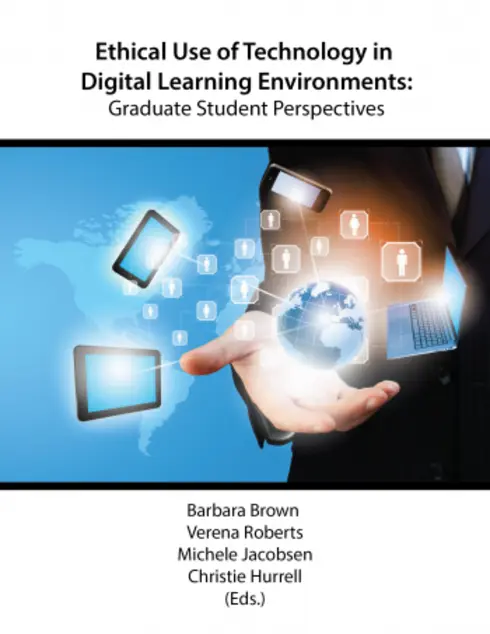
Ethical Use of Technology in Digital Learning Environments: Graduate Student Perspectives
![]()
![]()
![]()
![]()
![]()
Barbara Brown
Verena Roberts
Michele Jacobsen
Copyright Year:
Publisher: University of Calgary
Language: English
Formats Available
Conditions of Use
![]() Attribution
Attribution
CC BY
Reviews
Reviewed by Morris Thomas, Director, Center for Excellence in Teaching, Learning, & Assessment, Howard University on 2/8/21
The book is comprehensive by providing content and context on the various issues involving ethical use of technology in digital learning environments. The authors covers information from admissions and access for the use and creation of... read more
![]()
![]()
![]()
![]()
![]()
Reviewed by Morris Thomas, Director, Center for Excellence in Teaching, Learning, & Assessment, Howard University on 2/8/21
Comprehensiveness
The book is comprehensive by providing content and context on the various issues involving ethical use of technology in digital learning environments. The authors covers information from admissions and access for the use and creation of technology in the digital learning spaces. However, more discussion or focus could have been placed on some of the topics covered and other topics could have been placed in another text. One could look at this as being an opportunity and a strength of this text, meaning it is so rich that it could have been expanded into another or possibly multiple texts. Nevertheless, the content provided is appropriately covered.
Content Accuracy
The text is up to date with the literature covered and referenced throughout the text. It is written from a research lens and therefore the voice of the text is unbiased and or is transparent about any posited positions presented throughout the text.
Relevance/Longevity
Any text involving technology could run the risk of being perceived as out-of-date due to the ever evolving technological landscape, however, this text will maintain relevance to the available literature due to its well contextualized presentation of the various aspects of ethical considerations for using technology in digital learning environments.
Clarity
One of the strongest aspects of this text is its clarity. The text is well-organized and clearly explains all technical terms used throughout the text. The readers should be able to follow along with clarity and understanding.
Consistency
The book is consistent as it pertains to the terminology used. However, the text is vast in content covered and the framework could have been strengthened by expanding on some topics and limiting the inclusion of other topics.
Modularity
The text has clear readability. As it pertains to using this text in a course, it depends on the instructors' philosophy on reading assignments, if one simply assigns full chapters, this text certainly hits the mark. The text also includes clear smaller sections of text with subheadings and subunits. The subunits presented should not cause much disruption to the reader.
Organization/Structure/Flow
The text is well-organized. In the introduction of the text, its content is clearly described and then as you read the text you find the information provided in a manner that is clear and sensible. The layout of the text makes the information included accessible for the reader.
Interface
I did not find evidence of any significant issues with the text's interface. The text was easy to read and navigate.
Grammatical Errors
The text is well edited and did not have evidence of any significant grammatical errors.
Cultural Relevance
There were no apparent instances of cultural insensitivity or offensive content throughout the text.
CommentsThis book certainly has value and will be used by me in courses I teach but also has value to me as one who provides training on teaching and learning. The text provides a rich resource to employing the ethical use of technology in digital learning spaces. This is conversation is needed more than ever as learning spaces continue to digitize.
Table of Contents
- Part I: Underlying Ethical Issues and Value of Technologies: Artificial Intelligence, Social Networking Services, 3D Printing
- Chapter 1: Ethical Considerations When Using Artificial Intelligence-Based Assistive Technologies in Education
- Chapter 2: Beware: Be Aware - The Ethical Implications of Teachers Who Use Social Networking Sites (SNSs) to Communicate
- Chapter 3: From Consumers to Prosumers: How 3D Printing is Putting Us in the Driver’s Seat for Creation and the Ethical Considerations that Accompany this Shift.
- Part II: Promoting Equity in Personalized Learning Contexts: Academic Resource Sharing, Adaptive Learning Systems, STEM, Assistive Technologies
- Chapter 4: Ethical Issues in Academic Resource Sharing
- Chapter 5: Adaptive Learning Systems in Modern Classrooms
- Chapter 6: STEM Beyond the Acronym: Ethical Considerations in Standardizing STEM Education in K-12
- Chapter 7: Considerations of Equitable Standards in the Implementation of Assistive Technology
- Part III: Nurturing Ethical Awareness in Institutional Contexts: Admissions and Communications
- Chapter 8: Who Gets In? Examining Ethics and Equity in Post-Secondary Admissions
- Chapter 9: To What Extent Does Fake News Influence Our Ability to Communicate in Learning Organizations?
About the Book
This book is the result of a co-design project in a class in the Masters of Education program at the University of Calgary. The course, and the resulting book, focus primarily on the safe and ethical use of technology in digital learning environments. The course was organized according to four topics based on Farrow’s (2016) Framework for the Ethics of Open Education.
About the Contributors
Authors
Barbara Brown
Verena Roberts
Michele Jacobsen
